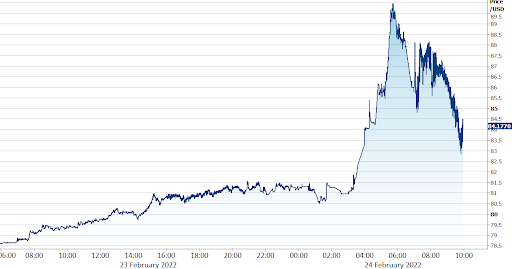Financial markets were left reeling on Thursday morning on the news that Russia had launched a full-scale military assault on Ukraine, with reports of missile strikes and explosions in major cities.
Unsurprisingly, we’re seeing clear risk off in FX in response to this morning’s news. The sell-off in risk assets has been led by the Russian rouble itself, which was down more than 8% at one stage to a fresh record low, although it has since recouped some of these losses. Most major currencies in the CEE region have followed suit, down more than one percent on the dollar for the day, with most other emerging market currencies also losing ground. Moves among the major currencies have so far been largely contained, although we have still witnessed sell-off in excess of half a percent in the higher risk ones, notably the Norwegian krone and Australian and New Zealand dollars. The euro and sterling are also down approximately half a percent, while the safe-haven US dollar and Japanese yen have both outperformed, as one would expect during periods of uncertainty.
Figure 1: USD/RUB (23/02/2022 – 24/02/2022)

Leaders around the world have responded by threatening tougher action on Russia. The EU is said to be preparing ‘massive sanctions’ on the country, with the US and UK among others almost certain to follow suit. This had led to a sharp move higher in oil prices, which are now at fresh 8-year highs above $103 a barrel. The impact on monetary policy in the long-term is less clear. While we see the developments as inflationary, the uncertainty created has caused markets to dial back on expectations for hikes, with futures now pricing in a mere 20% chance of a 50 basis point hike from the Fed in March, and only an 80% chance of a 25 basis point one.
While moves in the majors have so far been largely contained, the path of least resistance for higher-risk currencies is lower as developments in Ukraine unfold. Unfortunately, the situation looks likely to deteriorate before it gets better, and the sell-off in risk appears to have more room to run in the near-term. Investors will be paying very close attention to the latest developments as they hit the newswires, and we expect markets to remain highly sensitive to incoming newsflow. If it wasn’t already the case before, news out of Ukraine will undoubtedly be the main driver of currencies for at least a little while yet.
To stay up to date with our publications, please choose one of the below:
📩 Click here to receive the latest market updates
👉 Our LinkedIn page for the latest news
✍️ Our Blog page for other FX market reports